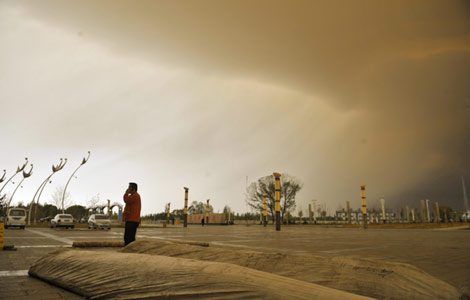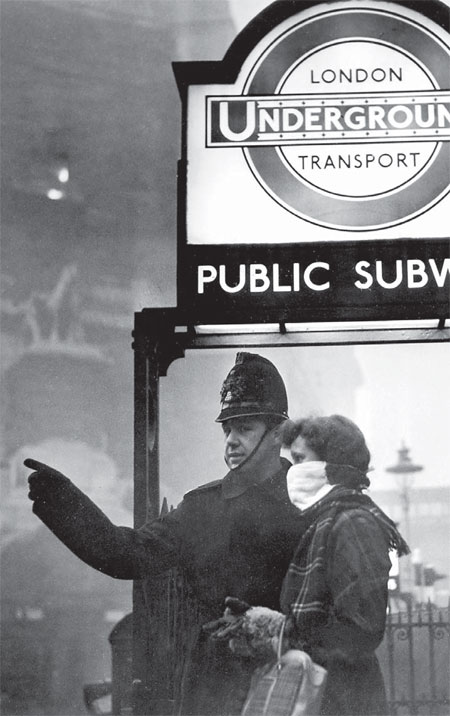Li pledges measures in fight for clean air
Updated: 2013-01-16 08:05
By Zhang Chunyan in London, Chen Jia in San Francisco and Wu Wencong, Tang Yue in Beijing (China Daily)
|
||||||||
|
Heavy smog in London's Piccadilly Circus in December 1952. Provided to China Daily |
|
The skyline of Los Angeles obscured by a heavy layer of smog and fog on July 15, 2003. Provided to China Daily |
|
A policeman assists a woman during a dense London fog in 1953. Provided to China Daily |
Vice-premier calls for immediate action as capital can learn from experience of other major cities that tackled pollution, report Zhang Chunyan in London, Chen Jia in San Francisco and Wu Wencong, Tang Yue in Beijing.
China will strengthen the enforcement of environmental laws, and take other measures to tackle air pollution, Vice-Premier Li Keqiang pledged on Tuesday.
"We published accurate PM2.5 data. It took a long time for this problem to accumulate, and it will take a long time to solve it," he said.
"But we must act! We have to strengthen the enforcement of environmental laws and other regulations and also remind the public to protect themselves."
Beijing has been shrouded in thick smog since Saturday. Levels of PM2.5 - particle matter smaller than 2.5 microns and able to enter the lungs and even the bloodstream - passed 300 micrograms per cubic meter on Saturday in 33 of the 74 cities with systems sensitive enough to monitor the particles. The World Health Organization considers the safe daily level to be 25 micrograms per cubic meter.
On his Sina Weibo account, John Ross, a former adviser of ex-London mayor Ken Livingstone and who now lives in Shanghai, said he was reminded of the Great Smog of 1952 in London. That incident claimed 4,000 lives over a period of two weeks and claimed a further 8,000 lives during the following months.
Meanwhile, Thomas Unnasch, a medical professor in San Francisco, thought of Los Angeles in the 1960s, even though the city's air at the time was cleaner than during the period of severe air pollution, known locally as the "gas attack", which caused 2,000 auto accidents in a single day in 1954.
China Daily canvassed the opinions of a number of international experts with regard to the action that can be taken to avoid the severe pollution that plagued London, LA and other cities half a century ago.
Problems old and new
"Beijing suffers from both London's old problem (coal-fired power stations) and London's new pollution problem (traffic)," said Frank Kelly, professor of environmental health at London University's King's College.
"To improve air quality, the Chinese authorities will need to tackle both of these problems."
During London's four-day Great Smog, "people who set off in their cars in what should have been daylight had to abandon them and walk, while buses gave up and crawled back to their depots in a nose-to-tail convoy", the Daily Telegraph reported at the time.
On July 26, 1943, a pall of smoke and fumes descended on downtown Los Angeles, cutting visibility to three blocks.
Because the "gas attack" hit in the middle of a heat wave, the atmosphere was close to unbearable, leaving residents with severely sore throats and stinging eyes, according to reports in the Los Angeles Times.
In 1953, heavy November smog in New York killed between 170 and 260 people. Meanwhile, in 1954, similarly severe conditions resulted in the temporary closure of businesses and schools in Los Angeles for most of October.
The incidents triggered a series of strict, detailed laws and regulations designed to combat air pollution.
London's great smog led to the enactment of the first piece of legislation to specifically target air pollution in the world, the Clean Air Act of 1956, which was later amended and extended by the 1968 Clean Air Act.
The acts regulated the burning of solid, liquid and gaseous fuels, and increased the height of new industrial chimneys, that had not been included in previous legislation.
The efforts made by the UK government and residents were finally rewarded when the number of foggy days in London was reduced from several dozen per annum to 15 in 1975, further improving to just five days per year in 1980.
Meanwhile, the US has improved air quality by instigating strict emission standards on power plants, factories and automobiles.
The heavy smog in Beijing during the past few days has not only prompted heated discussion about comparisons between the three Western cities and the Chinese capital, but also led the public to ask questions such as, "What can we learn from the experiences of London and LA in tackling pollution". More directly people have asked, "Do we stand a chance of seeing the end of incidents such as these?"
Complicated situation
Experts said the intensity of pollution China faces today is not as severe as the US and UK experienced previously, but the scale is much larger and the causes are far more complicated.
When the developed countries tackled air pollution caused by burning coal, industrial pollution was not a major problem, and therefore they could deal with the problem incrementally, said Ming Dengli, head of the international cooperation office at the Beijing environmental bureau.
The battle against PM2.5 and ozone pollution started at a very late stage in the process.
However, Beijing's air pollution is characterized by a combination of coal-fired pollution, industrial pollution, motor vehicle emissions and dust, which have emerged almost simultaneously, he said.
"In the case of Beijing, the government has done almost everything that can be done, but with air pollution being a regional issue, there is no chance that the capital can make any significant changes in just a few days," said Zhang Lei, an associate professor focusing on studies into environmental policies at the School of Environment and Natural Resources at Renmin University of China.
However, she insisted that there are still lessons to be learned from the experiences of other cities, the first being effective implementation of the relevant laws.
It took London about 20 years to lose the nickname "The City of Fog" following the enactment of the Clean Air Act 1956. By comparison, China is still facing severe smog and haze 40 years after the introduction of relevant laws.
Selling the policy
"Looking back 50 years, I can't imagine there are many people now who don't recognize that this was the right policy," wrote Ken Livingstone in an official memoir of the 1952 smog incident, published in 2002.
In the UK, there was a great deal of public discontent after the government passed legislation aimed at phasing out coal fires in response to the 1952 incident. It meant that before the widespread adoption of central heating many people had to use paraffin heaters and there was great resistance to change.
The lesson can also be applied to China.
It is wrong to believe that a lack of cooperation by the public results from a lack of awareness, said Zhang. More often, people don't change the way they behave because they are restricted by external conditions.
"If the government wants a higher take-up rate for public transport, they need to make it a better choice for the people," she said. "Traveling by bus or subway is a pleasant experience in many countries. The transport arrives on time and is always not crowded."
Greater public involvement in the decision-making process is also essential, said Ira S. Richards, a toxicologist and professor of public health at the University of South Florida.
"In the US, communities have some say in the production of the standard. Chinese communities have greater awareness today and they should play an important role in producing the standards for anti-air pollution," Richards said.
Shifting the problem
"This pollution is an extreme case. Beijing's air quality now is better than in 2008, as can be seen from the average whole-year figure for 2012," said Su Yang, a senior research fellow at the Development Research Center of the State Council.
The quality of the air in China's capital has improved for 14 consecutive years, with the number of major pollutants falling.
The municipal government has been taking measures to cut coal consumption in the city for a number of years. Approximately 700,000 metric tons of coal was saved in 2012 alone, thanks to projects that shifted the fuel source to forms of clean energy.
More than 300,000 old vehicles that failed to meet the city's emission standard, highest number in the country, were taken off the roads in 2012.
Regarding industrial pollution, the ultimate measure may be to ship it to somewhere else, according to Gerard Kuperus, an assistant professor of environmental studies at the University of San Francisco.
"China is today producing most of our electronics and consumer products. Providing electricity for such large-scale production creates massive pollution. In a sense, the way in which the US and Europe 'solved' part of their pollution problem is now causing pollution in other parts of the world, such as China. As we ship our products from China, we have, so to speak, 'shipped' part of our air pollution to that part of the world. While China has seen tremendous economic growth, the people are paying for it with their health."
Peng Yining contributed to this story.
Contact the reporters at wuwencong@chinadaily.com.cn, tangyue@chinadaily.com.cn and zhangchunyan@chinadaily.com.cn


(China Daily 01/16/2013 page6)

 In Photos: 7.0-magnitude quake hits Sichuan
In Photos: 7.0-magnitude quake hits Sichuan
 Li Na on Time cover, makes influential 100 list
Li Na on Time cover, makes influential 100 list
 FBI releases photos of 2 Boston bombings suspects
FBI releases photos of 2 Boston bombings suspects
 World's wackiest hairstyles
World's wackiest hairstyles
 Sandstorms strike Northwest China
Sandstorms strike Northwest China
 Never-seen photos of Madonna on display
Never-seen photos of Madonna on display
 H7N9 outbreak linked to waterfowl migration
H7N9 outbreak linked to waterfowl migration
 Dozens feared dead in Texas plant blast
Dozens feared dead in Texas plant blast
Most Viewed
Editor's Picks

|

|

|

|

|

|
Today's Top News
Live report: 7.0-magnitude quake hits Sichuan, heavy casualties feared
Boston suspect cornered on boat
Cross-talk artist helps to spread the word
'Green' awareness levels drop in Beijing
Palace Museum spruces up
First couple on Time's list of most influential
H7N9 flu transmission studied
Trading channels 'need to broaden'
US Weekly

|

|











